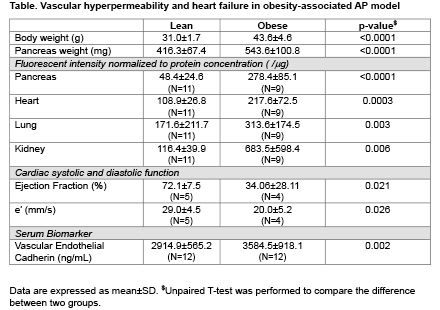Final ID: Mo1008
Systemic Vascular Damage and Cardiac Dysfunction in a Mouse Severe Acute Pancreatitis Model
Abstract Body (Do not enter title and authors here): Background and Objective: Decline of cardiovascular (CV) function is commonly observed in patients with severe acute pancreatitis (AP), which is associated with high mortality and morbidity. While the pathological changes in the pancreas during severe AP have been extensively studied, the impact on the CV system has not been well characterized. Furthermore, obesity is a major risk factor for severe AP. Hereby we utilized an obesity-associated mouse AP model to assess potential alterations in vascular integrity and cardiac function, two major components of circulatory failure.
Methods: Wild-type male C57BL6J mice were fed a normal or a high fat (to induce obesity) diet. Both groups received intraperitoneal injection of cerulein (100 mg/kg/h x12) to induce AP. H&E and TUNEL staining of pancreas were performed to assess histology and cell death. To measure vascular integrity, we measured the leakiness of a fluorescein-conjugated dextran (70 kDa) in tissue parenchyma and serum levels of soluble vascular endothelial (VE)-cadherin, which has recently shown to be shed from endothelial cells with disrupted adherens junctions. Cardiac systolic and diastolic function were assessed by echocardiography at baseline and post-AP induction.
Results: Compared to lean mice, obese mice developed more severe pancreatic edema, cell death and inflammatory cell infiltration, along with significantly increased accumulation of fluorescent dextran in multiple organs including pancreas, heart, lung, and kidney, suggesting systemic disruption of vascular integrity. Increased serum levels of soluble VE-cadherin in obese mice (vs. lean) after AP induction further supported compromised endothelial cell barrier function. At baseline, obese mice exhibited similar cardiac function to lean mice. However, obese mice, but not lean mice, developed impaired systolic and diastolic function post-AP induction, as supported by decreased ejection fraction and e’ velocity respectively.
Conclusion: In this obesity-associated severe AP mouse model, systemic vascular permeability is increased, and cardiac function is substantially compromised. Systemic vascular hyperpermeability and cardiac dysfunction may represent therapeutic targets to enhance the outcomes in severe AP.
Methods: Wild-type male C57BL6J mice were fed a normal or a high fat (to induce obesity) diet. Both groups received intraperitoneal injection of cerulein (100 mg/kg/h x12) to induce AP. H&E and TUNEL staining of pancreas were performed to assess histology and cell death. To measure vascular integrity, we measured the leakiness of a fluorescein-conjugated dextran (70 kDa) in tissue parenchyma and serum levels of soluble vascular endothelial (VE)-cadherin, which has recently shown to be shed from endothelial cells with disrupted adherens junctions. Cardiac systolic and diastolic function were assessed by echocardiography at baseline and post-AP induction.
Results: Compared to lean mice, obese mice developed more severe pancreatic edema, cell death and inflammatory cell infiltration, along with significantly increased accumulation of fluorescent dextran in multiple organs including pancreas, heart, lung, and kidney, suggesting systemic disruption of vascular integrity. Increased serum levels of soluble VE-cadherin in obese mice (vs. lean) after AP induction further supported compromised endothelial cell barrier function. At baseline, obese mice exhibited similar cardiac function to lean mice. However, obese mice, but not lean mice, developed impaired systolic and diastolic function post-AP induction, as supported by decreased ejection fraction and e’ velocity respectively.
Conclusion: In this obesity-associated severe AP mouse model, systemic vascular permeability is increased, and cardiac function is substantially compromised. Systemic vascular hyperpermeability and cardiac dysfunction may represent therapeutic targets to enhance the outcomes in severe AP.
More abstracts on this topic:
5-oxoproline/ OPLAH Axis Alleviates Doxorubicin-induced Cardiomyopathy By Inhibiting Ferroptosis
Jiang Meng, Guo Xinning
A Community-Based Intervention to Improve Cardiovascular Health Understanding in the Dallas-Fort Worth South Asian CommunityDeo Parminder, Rohatgi Anand, Sharma Parul, Sathyamoorthy Mohanakrishnan

